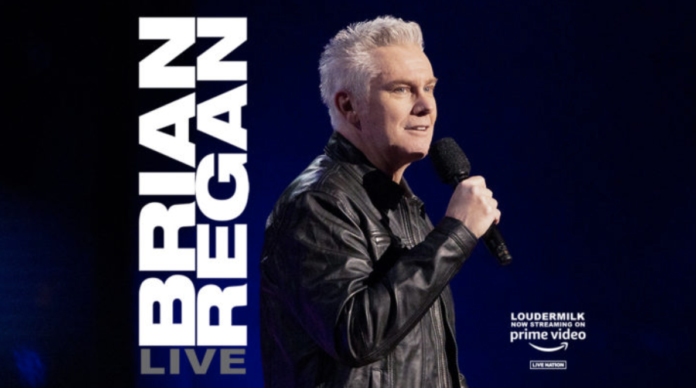Comedian Brian Regan Performs April 7-8 2023 at Washington DC’s The Kennedy Center
Considered one of the best stand-ups in the country by critics, fans and fellow comedians,
Brian Regan announces new theater tour dates through the spring of 2023.
Since 2005, Brian’s non-stop theater tour has visited the most beautiful venues in North America. Produced by Live Nation, the 30-city tour kicks off on Saturday, December 31st at Will Rogers Auditorium in Fort Worth making stops across the U.S. in Philadelphia, Salt Lake City, Washington and more before wrapping up in Jacksonville at the Florida Theater on May 14th. For full tour dates and links to purchase tickets visit Brian’s website.
Tickets go on sale starting Friday, September 16th at 10am local time on BrianRegan.com
BRIAN REGAN NYE & SPRING 2023 TOUR DATES:
Saturday, December 31, 2022 – Fort Worth, TX – Will Rogers Auditorium
Thursday, January 12, 2023 – Burlington, VT – The Flynn
Friday, January 13, 2023 – Syracuse, NY – The Oncenter Crouse Hinds Theater
Saturday, January 14, 2023 – Philadelphia, PA – Miller Theater- PA
Sunday, January 15, 2023 – Charlottesville, VA – Paramount Theatre- Charlottesville
Tuesday, January 31, 2023 – Edmonton, AB – Winspear Centre
Wednesday, February 1, 2023 – Calgary, AB – Jack Singer Concert Hall
Thursday, February 2, 2023 – Surrey, BC – Bell PAC
Friday, February 3, 2023 – Tacoma, WA – Pantages Theater
Saturday, February 4, 2023 – Salem, OR – Elsinore Theatre
Thursday, February 23, 2023 – Grand Junction, CO – Avalon Theatre
Saturday, February 25, 2023 – Billings, MT – Alberta Bair Theater
Thursday, March 2, 2023 – El Cajon, CA – The Magnolia
Friday, March 3, 2023 – Thousand Oaks, CA – Bank of America PAC
Saturday, March 4, 2023 – Wheatland, CA – Hard Rock Live
Sunday, March 5, 2023 – Santa Rosa, CA – Luther Burbank Center for the Arts
Wednesday, March 15, 2023 – Salt Lake City, UT – Delta Hall at The Eccles
Wednesday, March 29, 2023 – Sioux Falls, SD – Washington Pavilion
Thursday, March 30, 2023 – Dubuque, IA – Five Flags Arena*
Friday, March 31, 2023 – Omaha, NE – Holland PAC
Saturday, April 1, 2023 – Rapid City, SD – Rushmore Theatre*
Thursday, April 6, 2023 – Norfolk, VA – Harrison Opera House
Friday-Saturday, April 7-8, 2023 – Washington DC – The Kennedy Center^
Tuesday, April 25, 2023 – Morgantown, WV – The Metropolitan Theatre
Thursday, April 27, 2023 – Shipshewana, IN – Blue Gate PAC*
Friday, April 28, 2023 – St Charles, IL – The Arcada Theatre*
Saturday, April 29, 2023 – Saint Joseph, MO – Missouri Theatre
Sunday, April 30, 2023 – Manhattan, KS – McCain Auditorium (KSU)*
Thursday, May 11, 2023 – Coral Springs, FL – Coral Springs Center for the Arts
Friday, May 12, 2023 – St Petersburg, FL – Mahaffey Theater
Saturday, May 13, 2023 – Fort Pierce, FL – Sunrise Theatre ^
Sunday, May 14, 2023 – Jacksonville, FL – Florida Theatre Jacksonville
^Already on sale
*Not a Live Nation date
Brian premiered his second Netflix stand-up special, Brian Regan: On The Rocks, on February 23, 2021. Brian’s first Netflix special, Brian Regan: Nunchucks And Flamethrowers, premiered to rave reviews on November 21, 2017, and is also available as a vinyl album.
In 2021, Brian returned for his third season in Peter Farrelly’s TV series, Loudermilk, which is streaming on Amazon Prime. Farrelly personally cast Brian in the series alongside Ron Livingston, Anja Savcic, Will Sasso and Mat Fraser. Brian received praise for his portrayal of “Mugsy,” a recovering addict who is estranged from his family.
Comedian Brian Regan stars in his own Netflix series, Stand Up And Away! With Brian Regan, which premiered on Christmas Eve 2018. Brian and Jerry Seinfeld Executive Produce the four-episode original half-hour series that combines sketch comedy and stand-up.



